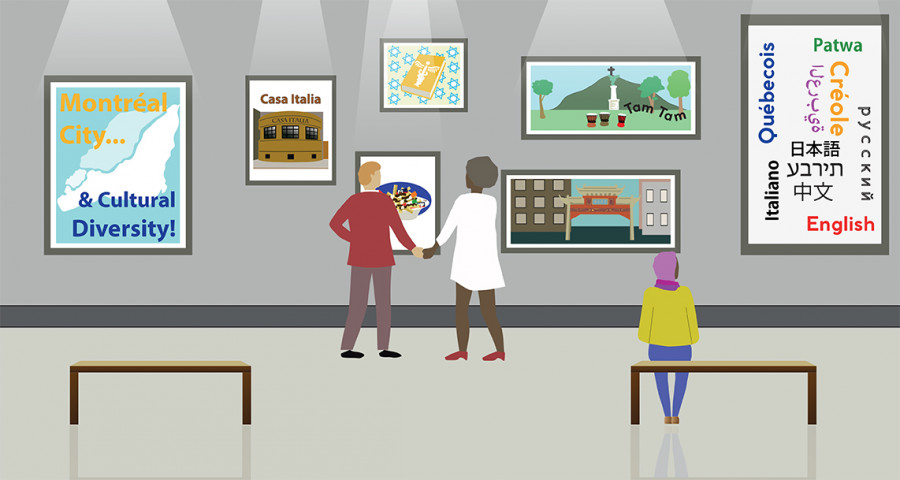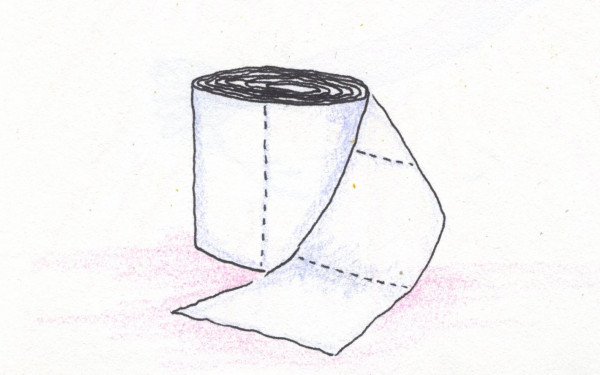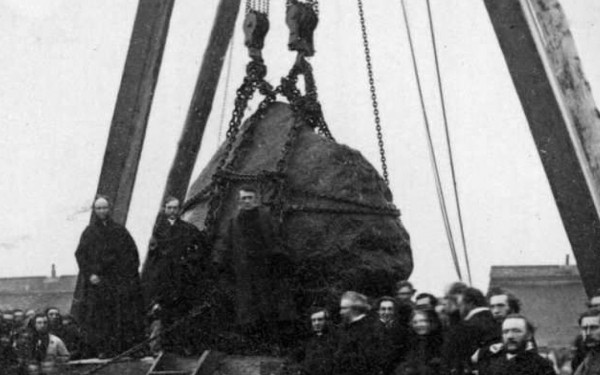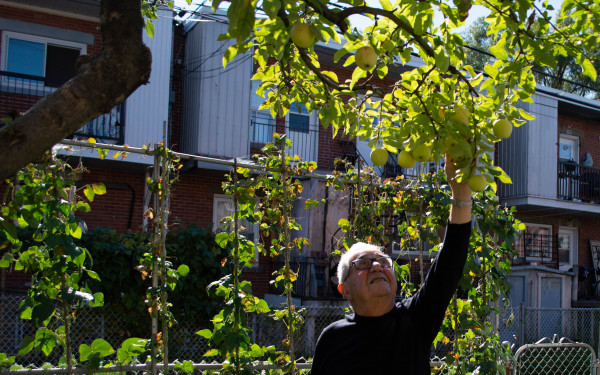How Immigration Has Shaped the City of Montreal
A Glance at Cultural Influence in the City
Montreal is home to many well-defined cultural communities, each with their own unique collective identities.
These groups lay roots in different areas of the city, forming distinct communities and villages, differentiated by their architectural styles. As the political motive for immigration transitioned from one of employment to one of multiculturalism, each of Montreal’s largest immigrant communities have transformed the city through their own diaspora.
The continued vibrance of these diasporas speaks to the resilience of maintaining themselves in a constantly evolving population.
Montreal is home to many Italians, their immigration spanning over the course of a century.
As fifth-generation Italians call Canada their home, they contribute to a post-national identity within a country that is constantly evolving in its identity, according to Dr. Raluca Fratiloiu, in her 2006 dissertation.
Italian immigration to Canada was a part of a larger migration toward an economically developing North America. Immigration policy centered around national projects like the construction of the Canadian Pacific Railway, provoking the migration of thousands of Italians to Canada.
Two pillars emerged from what centred the idea of early Italian immigrant identity: one based upon their hometown and one of their sense of italianità (Italianess), provoked by the uncertainty of living in a new, foreign environment.
Creating buildings that stood for them as a community carried great symbolic importance. The vitality and determination of Montreal’s Italian community is symbolized in the cultural patrimony of the Casa d’Italia.
Opening in 1936, the Casa d’Italia was a festive and historic meeting place for Italians and their French-Canadian neighbours.
The twentieth century art deco building, erected for newly settled Italian Canadians, became the heart and soul of Italian community life.
Post-war immigration policy saw a transformation that favoured Italian immigration for unskilled and semi-skilled labour to fill the gaps of industrial labour forces. Italians in the post-war context no longer immigrated to escape misery, but to advance economically, as there was an increasing need for jobs in the service industry.
This coincided with a 1962 change in immigration policy that abandoned Canada’s previous, overtly racist, Immigration Acts of 1910, 1919, and 1952.
These acts restricted admission to white American, British, and European applicants, favouring a points-based system with preference given to eligible of-age workers that spoke French, English, or
both.
Due to an influx of immigrants of various backgrounds, Montreal was the most populated and wealthy city in Canada throughout the 1960s and a major centre of North American industrialization and expansion.
From the 1970s until the early 1990s, new and important organizations anchored themselves within the Casa d’Italia.
These included the Quebec chapter of the National Congress of Italian-Canadians, the Italian-Canadian Community Foundation, the Italo-Canadian Seniors’ Council , the Servizi Comunitari Italo-Canadesi and became the home of the Italian cultural centre.
Other sites of italianita evoke a discourse of nostalgia and belonging, such as the Café Italia on St. Laurent Blvd.
Within its walls, Italians can reconnect to a distant homeland and channel feelings of nostalgia a sense of italianita is evoked through the café’s products, its wooden tables and retro décor of soccer champions and Italian Canadian characters.
The café allows the stories of first generation Italian Montrealers to come full circle as they fulfill a sense of belonging to their homeland, as a place that holds these emotions.
Immigrants from across the globe have found similar communities in Montreal, all contributing their own thoughts, art, and inspirations.
A growing community of immigrants from Haiti demonstrated the multi-faceted nature of politics in Montreal. Harvin Hilaire, ex-VP External Affairs for the Haitian Students’ Association of Concordia, feels that the Haitian community has left an impact on Montreal’s cultural scene.
“Personally, I feel that the Haitian community has a great impact on Montreal’s culture from our food, the music we dance to, and to our language,” said Hilaire. “You can see that a lot of our culture has been adapted by other communities in Montreal. [The influence of Haitian immigrants] is probably due to the fact that there are so many Haitians [here], but it’s only normal due to the fact that Haiti is so close to here and the French language is easier to adopt for Haitian immigrants.”
“Personally, I feel that the Haitian community has a great impact on Montreal’s culture from our food, the music we dance to, and to our language. You can see that a lot of our culture has been adapted by other communities in Montreal.” —Harvin Hilaire
In one way, their political struggle challenged preconceived notions of revolts in First and Third World countries. On one hand, Montreal could be seen as an imperial metropole, where those who held power in Western capital could direct the economic fate of the Caribbean.
Caribbean immigrants and emerging new political groups became essential to defining new democratic frameworks, as activists challenged racism and demanded real changes in economic, cultural, political, and educational spheres.
In the more distant past, Irish Montrealers, as a linguistic minority group, struggled against French Canadian exclusionary policy.
The Irish community in Montreal have served as a crucial bridge between the French, who adopted Irish orphans from the first arrival of migrants in the late ninetheenth century, and the English, who share history and language.
A large settlement of Irish immigrants in the 1840s and 1850s led to violent outbursts with French Canadian rural labourers, both in fierce competition for seasonal jobs as longshoremen in Montreal’s port.
At the end of the nineteenth century Montreal became a French-speaking city, within a province governed by a powerful English-speaking minority of Brits and Scots, that stood in juxtaposition to a struggling subgroup of Irish people originating from Great Britain.
The Irish improved their socio-economic status in this period, yet participated widely as both employer and employee in commerce, industry, and professional oeuvriers. Irish settlers inhabited working-class neighborhoods in Montreal’s south-west such as Griffintown, Pointe Saint-Charles, Verdun, and Lasalle, in modest working-class to middle-class homes.
Researcher Charles Boberg at McGill University says that the Irish are the earliest social group to immigrate in large numbers.
Over time, Boberg believes that the Irish became the least distinct of a large group of immigrant settlers in Montreal and linguistically, have lost their identity.
As Irish neighborhoods broke up and intermarriage became widely accepted between them and French Canadians or other settlers from Great Britain, the Irish assimilated more into Francophone society, while the other portion blended in with other English-speaking European groups to form an Anglophone distinction on their own.
Irish identity is making a comeback through a historical commemoration project, making headway on the Montreal side of the Victoria Bridge.
A memorial park is to be constructed around the Black Rock to remember over 6,000 Irish immigrants who died and were buried there in 1847 as a result of typhus fever. Negotiations between the Montreal Irish Committee, Hydro-Québec, and the municipal government are ongoing for relocating Bridge Street, so that visitors can stand directly in front of the Black Rock to easily read its inscription and commemorate a dark beginning.
Relative to other groups, the survival and development of Montreal’s Jewish community came out of the response of a “reluctant host” group.
Before World War II, the Jewish community was struggling with confronting the linguistic, political, and socio-economic institutions of the anglophone and francophone communities of Montreal.
As they endeavored to establish themselves, the Federal government was willing to open its doors to foreigners to develop Canada’s industry, but the Bourassa provincial government preferred to maintain the bilingual compact of Confederation and spread French-Canadian settlement across the province to develop land.
The successes of the Jewish community ensured that inter-ethnic relations would plant the seeds for a vibrant ethnic pluralism in Montreal. Jonathan Mamane, a student at Concordia University, recounts the sense of vibrancy and celebration that holds Montreal’s Jewish community together.
“Jewish communities usually get together for celebrations, and we have lots of those,” he says. “In Jewish culture, celebrations can take place anywhere there are enough people to throw a party.”
While Jewish community gathering isn’t tied down to any particular place, Jewish schools, the Jewish General Hospital, and the Young Men’s-Young Women’s Hebrew Association demonstrate that Montreal’s Jewish community was compelled by the dominant anglophone and francophone counterparts to develop their own resources and institutional autonomy.
All public institutions in Montreal were regulated by Catholic and Protestant authority, which held an almost imperial force within society. This situation pushed the schooling system to request from the provincial government that Jews be identified as a neutral party, which received stark opposition from Jewish immigrants, objecting to their erasure.
School boards were unable to provide Jewish teachers or appoint Jewish Representatives to their Board of Governors until a court ruling stated that Quebec could create a separate Jewish education system within its mandate by 1930.
Even prior to World War II, religious prejudice was present in Montreal. Jewish people would encounter difficulties obtaining health care and finding employment in hospitals.
What began as a series of clinics the early twentieth century expanded into a single hospital unit as more immigrants arrived within ten years.
The YM-YWHA started in Montreal in 1910, in a room rented for $7.50/month within the Baron de Hirsch Institute.
Sir Mortimer B. Davis was a philanthropist that granted a sizeable donation to expand the centre into a larger facility in 1929, which later on became the namesake of the Jewish General Hospital. As both institutions overcame the financial strains of the Great Depression and benefitted from their popularity, they expanded their services as the Jewish General Hospital purchased land to develop wings in specialized care, and the YMHA was regarded as a community centre as well as a private club.
It is interesting to note that similar motivations pushed Jewish and Italian parents to select anglophone schooling.
They were guided by the same desire to prepare their children for a competitive job market, looking to the Canadian nation as a whole, much to clerical discontent in Montreal.
By having ethnically sensitive schooling systems that adopted a trilingual approach, the city’s plurilingual character allowed opportunities for anglophone communities to assist in fulfilling the ambitions of immigrants wanting to settle into Montreal’s metropolitan society.
Overall, Montreal resembles other northeastern cities that had similar immigration flows over the nineteenth and twentieth centuries.
Political organizing and institutional independence has never ceased amongst any of these groups, thus becoming their own nations in the city.
As each of these groups exists in response to French Canadian institutions and cultural imposition, it causes one to question if there really is a foreign or anglophone scare to justify erecting exclusionary policies.
Many of these groups continually clash with agendas of language, education, and civic engagement, despite that some groups share cultural exchanges with French Canadians as francophone minorities.
Montreal remains a city trapped between an immigration-led pluralistic society, bound by multicultural monuments and organizations, and a provincial government seeking francophone uniformity.
What we do know, is that the better-appreciated parts of Montreal culture were conceived through cultural exchange and not uniformity.






